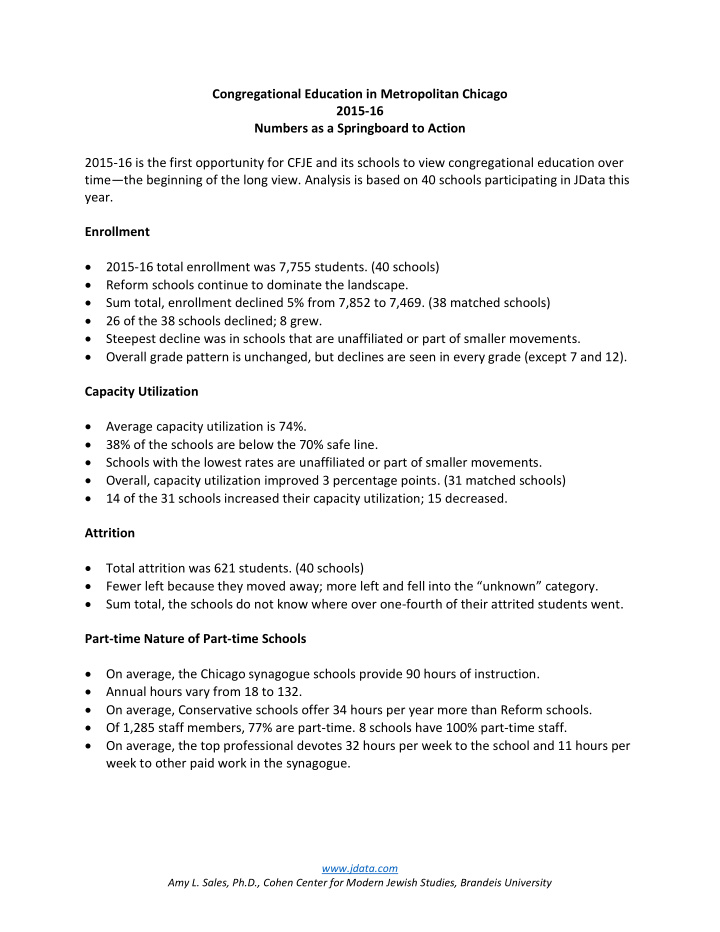



Congregational Education in Metropolitan Chicago 2015-16 Numbers as a Springboard to Action 2015-16 is the first opportunity for CFJE and its schools to view congregational education over time — the beginning of the long view. Analysis is based on 40 schools participating in JData this year. Enrollment 2015-16 total enrollment was 7,755 students. (40 schools) Reform schools continue to dominate the landscape. Sum total, enrollment declined 5% from 7,852 to 7,469. (38 matched schools) 26 of the 38 schools declined; 8 grew. Steepest decline was in schools that are unaffiliated or part of smaller movements. Overall grade pattern is unchanged, but declines are seen in every grade (except 7 and 12). Capacity Utilization Average capacity utilization is 74%. 38% of the schools are below the 70% safe line. Schools with the lowest rates are unaffiliated or part of smaller movements. Overall, capacity utilization improved 3 percentage points. (31 matched schools) 14 of the 31 schools increased their capacity utilization; 15 decreased. Attrition Total attrition was 621 students. (40 schools) Fewer left because they moved away; more left and fell into the “unknown” category. Sum total, the schools do not know where over one-fourth of their attrited students went. Part-time Nature of Part-time Schools On average, the Chicago synagogue schools provide 90 hours of instruction. Annual hours vary from 18 to 132. On average, Conservative schools offer 34 hours per year more than Reform schools. Of 1,285 staff members, 77% are part-time. 8 schools have 100% part-time staff. On average, the top professional devotes 32 hours per week to the school and 11 hours per week to other paid work in the synagogue. www.jdata.com Amy L. Sales, Ph.D., Cohen Center for Modern Jewish Studies, Brandeis University
Professional Development The majority of teachers have degrees related to education. Dollars for professional development still average about 2% of budgeted expenses. Schools budgeted an average of $162 per teacher for development, marginally higher than last year. 16 schools reduced the amount; 10 schools increased the amount. More schools are paying teachers for time spent on professional development. Top learning priority for teachers is technology; second is classroom management and learning styles. Learning priorities for the top educator are varied and high level. 307 volunteers serve on school boards/committees. Learning priorities for them include strategic planning, fundraising, and “ how to be committed and carry through with tasks. ” Thing are Getting Bigger School expenses increased an average of 18%. (33 matched schools) 14 schools had larger budgets than last year; 17 had smaller budgets. Revenues increased by an average of 10%. (27 matched schools) 10 schools had greater revenues and 13 had lower revenues than last year. Average tuition is up by 6%. Tuition increased in both Conservative and Reform settings but declined in other settings. Tuition increased for every grade. Total financial aid reached almost $400,000 and went to over 820 unique recipients. Average total dollars grew by 65% and number of recipients grew by 20%. (17 matched schools) From Data to Action Ten schools (28%) have a formal strategic plan with goals and objectives for the school ’ s educational direction and growth over the next three to five years. The others do not. www.jdata.com Amy L. Sales, Ph.D., Cohen Center for Modern Jewish Studies, Brandeis University
Jewish Early Childhood Education in Metropolitan Chicago 2015-16 The Story as Told by (J)Data 2015- 16 is the first year that Chicago’s Jewish early childhood programs participated in community-wide, systematic data collection. The results offer a first view of the landscape and serve as a baseline for future tracking. Strengths 1. The system has data: Core and custom from 31 of 36 programs. 2. The system is large: Over 30 programs serving approximately 2,900 children from 2,400 families and employing over 670 professionals and other staff. 3. The system has significant human resources : a cadre of top professionals with up to 20 years or more of experience; at least 450 professionals with relevant educational backgrounds; and 260 lay leaders with an interest in early childhood education. 4. The system is variegated: different parent organizations, denominations, sizes, program offerings, and experience at the top. 5. The system has positive indicators: low teacher turnover, healthy average capacity utilization, majority Jewish children, and “ loving ” tracking systems. Opportunities 6. The system has practical opportunities: social media, teacher salaries and benefits, professional development. 7. The system has interesting questions to ponder: school population, recruitment and retention, incentives, financial aid, governance, accreditation. www.jdata.com Amy L. Sales, Ph.D., Cohen Center for Modern Jewish Studies, Brandeis University
Recommend
More recommend